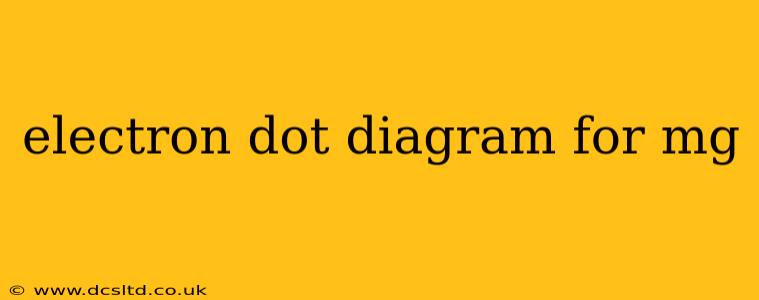Magnesium (Mg) is an alkaline earth metal with an atomic number of 12. Understanding its electron configuration is crucial to predicting its chemical behavior. This article will explain how to draw the electron dot diagram for magnesium and answer some frequently asked questions.
What is an Electron Dot Diagram?
An electron dot diagram, also known as a Lewis dot structure, is a visual representation of the valence electrons of an atom. Valence electrons are the electrons in the outermost shell of an atom, and they are the ones involved in chemical bonding. The diagram uses dots to represent these valence electrons, placed around the element's symbol.
How to Draw the Electron Dot Diagram for Magnesium (Mg)
-
Determine the number of valence electrons: Magnesium has an atomic number of 12, meaning it has 12 electrons. Its electron configuration is 1s²2s²2p⁶3s². The outermost shell (the 3rd shell) contains two electrons. Therefore, magnesium has two valence electrons.
-
Write the element symbol: Write the chemical symbol for magnesium, which is Mg.
-
Place the valence electrons: Place two dots around the Mg symbol, representing the two valence electrons. It doesn't matter where you place the dots; common practice is to place them one at a time on opposite sides.
The resulting electron dot diagram for magnesium is:
.Mg.
Why is the Electron Dot Diagram Important for Magnesium?
The electron dot diagram helps us understand magnesium's reactivity. With only two valence electrons, magnesium readily loses these electrons to achieve a stable octet (a full outer shell), gaining a +2 charge. This makes magnesium highly reactive and explains why it readily forms ionic compounds with nonmetals.
What are some common compounds formed by Magnesium?
Magnesium's tendency to lose two electrons leads to the formation of various ionic compounds. Some examples include:
- Magnesium oxide (MgO): Magnesium reacts with oxygen to form magnesium oxide, a stable ionic compound.
- Magnesium chloride (MgCl₂): Magnesium reacts with chlorine to form magnesium chloride.
- Magnesium hydroxide (Mg(OH)₂): Magnesium reacts with hydroxide ions to form magnesium hydroxide.
These compounds demonstrate magnesium's ability to readily form ionic bonds.
What is the difference between magnesium's electron dot diagram and other elements?
The number of valence electrons determines how many dots appear in the electron dot diagram. Elements in different groups on the periodic table have different numbers of valence electrons, leading to different dot diagrams. For example, an alkali metal like sodium (Na) would have only one dot, while a halogen like chlorine (Cl) would have seven dots.
How does the electron dot diagram help predict chemical reactions?
The electron dot diagram visually shows how many electrons an atom needs to gain or lose to achieve a stable octet. This helps predict how atoms will interact to form chemical bonds, whether ionic or covalent. For magnesium, its two valence electrons indicate its strong tendency to lose these electrons and form ionic bonds.
This comprehensive explanation provides a clear understanding of magnesium's electron dot diagram and its significance in predicting its chemical behavior. Remember, understanding electron configurations is a cornerstone of chemistry!
